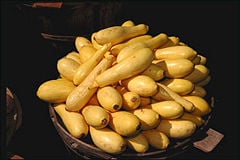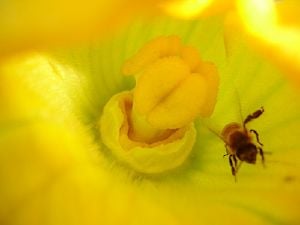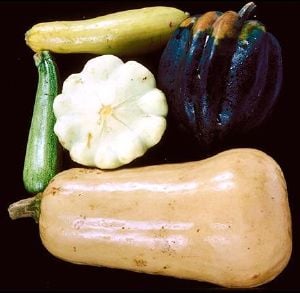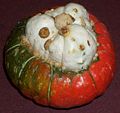Difference between revisions of "Squash (plant)" - New World Encyclopedia
Rick Swarts (talk | contribs) |
Rick Swarts (talk | contribs) |
||
| Line 18: | Line 18: | ||
}} | }} | ||
| − | '''Squash''' is the common name used for four [[species]] in the [[genus]] ''Cucurbita'' of the [[gourd]] family ''Cucurbitaceae'': '''''C. pepo''''', '''''C. maxima''''', '''''C. mixta''''', and '''''C. moschata'''''. These plants, which originated in the [[Americas]], are tendril-bearing plants characterized by hairy stems, unisexual [[flower]]s, and a fleshy fruit with a leathery rind that is a type of false berry called a [[pepo]]. The name squash also is used for the edible fruit of any of these plants, which can vary considerably in shape, color, and size, and is consumed as a [[vegetable]]. | + | '''Squash''' is the common name used for four [[species]] in the [[genus]] ''Cucurbita'' of the [[gourd]] family ''Cucurbitaceae'': '''''C. pepo''''', '''''C. maxima''''', '''''C. mixta''''', and '''''C. moschata'''''. These plants, which originated in the [[Americas]], are tendril-bearing plants characterized by hairy stems, unisexual [[flower]]s, and a fleshy fruit with a leathery rind that is a type of false berry called a [[pepo]]. The name squash also is used for the edible fruit of any of these plants, which can vary considerably in shape, color, and size, and is consumed as a [[vegetable]]. |
In North America, squash is loosely grouped into [[summer squash]] or [[winter squash]], as well as autumn squash (another name is cheese squash) depending on whether they are harvested as immature fruits (summer squash) or mature fruits (autumn squash or winter squash). [[Gourd]]s are from the same family as squashes. Well known types of squash include the [[pumpkin]] and [[zucchini]]. | In North America, squash is loosely grouped into [[summer squash]] or [[winter squash]], as well as autumn squash (another name is cheese squash) depending on whether they are harvested as immature fruits (summer squash) or mature fruits (autumn squash or winter squash). [[Gourd]]s are from the same family as squashes. Well known types of squash include the [[pumpkin]] and [[zucchini]]. | ||
| Line 27: | Line 27: | ||
==Description== | ==Description== | ||
| − | '''Cucurbitaceae''' | + | The four species of squash belong to the '''Cucurbitaceae''', a [[flowering plant]] family commonly known as gourds or cucurbits and including crops like [[cucumber]]s, [[luffa]]s, [[melon]]s, and [[watermelons]]. The family is predominantly distributed around the tropics, where those with edible fruits were among the earliest cultivated plants in both the Old and New Worlds. The Cucurbitaceae is sometimes known as the gourd family and sometimes as the squash family. |
| + | |||
| + | Most of the plants in this Cucurbitaceae family are [[Annual plant|annual]] [[vine]]s ,but there are also woody lianas, thorny [[shrub]]s, and [[tree]]s (''[[Dendrosicyos]]''). Many species have large, yellow or white flowers. The stems are hairy and pentangular. Tendrils are present at 90 degrees to the leaf petioles at nodes. (In botany, a tendril is a specialized stem, leaf, or petiole with a threadlike shape that is used by climbing plants for support and attachment, generally by twining around whatever it touches.) Leaves are exstipulate, alternate, simple palmately lobed or palmately compound. The flowers are unisexual, with male and female flowers usually on different plants (dioecious), or less common on the same plant (monoecious). The female flowers have [[Ovary (plants)#Inferior ovary|inferior ovaries]]. The fruit is often a kind of [[berry]] called a [[Epigynous_berry|pepo]]. The pepo, derived from an inferior ovary, is characteristic of the Cucurbitaceae. | ||
| + | |||
| + | '''Squashes''' generally refer to four species of the genus '''''Cucurbita''''' native to the [[New World]], also called ''marrows'' depending on variety or the nationality of the speaker. Archaeological evidence suggests that squash may have been first cultivated in [[Mesoamerica]] some 8,000 to 10,000 years ago (Roush 1997; Smith 1997), but may have been independently cultivated elsewhere, albeit later (Smith 2006). Squash was one of the "[[Three Brothers (agriculture)|Three Sisters]]" planted by [[Indigenous peoples of the Americas|Native Americans]]. The Three Sisters were the three main indigenous plants used for agriculture: [[maize]] (corn), [[beans]], and squash. These were usually planted together, with the cornstalk providing support for the climbing beans, and shade for the squash. The squash vines provided ground cover to limit weeds. The beans provided [[nitrogen fixing]] for all three crops. | ||
| − | |||
| − | |||
| − | |||
Summer squashes, including young vegetable marrows (such as [[zucchini]] [also known as courgette], [[Pattypan squash|pattypan]] and [[Yellow crookneck squash|yellow crookneck]]) are harvested during the growing season, while the skin is still tender and the fruit relatively small, they are consumed almost immediately and require little or no cooking. | Summer squashes, including young vegetable marrows (such as [[zucchini]] [also known as courgette], [[Pattypan squash|pattypan]] and [[Yellow crookneck squash|yellow crookneck]]) are harvested during the growing season, while the skin is still tender and the fruit relatively small, they are consumed almost immediately and require little or no cooking. | ||
| Line 39: | Line 40: | ||
Winter squashes (such as [[butternut squash|butternut]], [[Hubbard squash|Hubbard]], buttercup, ambercup, [[Acorn squash|acorn]], [[spaghetti squash]] and [[pumpkin]]) are harvested at maturity, generally the end of summer, cured to further harden the skin, and stored in a cool place for eating later. They generally require longer cooking time than summer squashes. (Note: Although the term ''winter squash'' is used here to differentiate from ''summer squash,'' it is also commonly used as a synonym for ''Cucurbita maxima''.) | Winter squashes (such as [[butternut squash|butternut]], [[Hubbard squash|Hubbard]], buttercup, ambercup, [[Acorn squash|acorn]], [[spaghetti squash]] and [[pumpkin]]) are harvested at maturity, generally the end of summer, cured to further harden the skin, and stored in a cool place for eating later. They generally require longer cooking time than summer squashes. (Note: Although the term ''winter squash'' is used here to differentiate from ''summer squash,'' it is also commonly used as a synonym for ''Cucurbita maxima''.) | ||
| − | The squash fruit is classified as a [[epigynous berry|pepo]] by botanists, which is a special type of berry with a thick outer wall or rind formed from hypanthium tissue fused to the [[exocarp]]; the fleshy interior is composed of [[mesocarp]] and [[endocarp]]. | + | The squash fruit is classified as a [[epigynous berry|pepo]] by botanists, which is a special type of berry with a thick outer wall or rind formed from hypanthium tissue fused to the [[exocarp]]; the fleshy interior is composed of [[mesocarp]] and [[endocarp]]. |
| + | |||
| + | An '''epigynous berry''' or '''false berry''' is an [[accessory fruit]] found in certain [[plant]] species with an ''[[ovary (plants)#Inferior ovary|inferior ovary]]'', distinguishing it from a true [[berry]]. In these species other parts of the flower (including the basal parts of the [[sepal]]s, [[petal]]s, and [[stamen]]s) can ripen along with the ovary, forming the false berry. The fruit of [[Cucurbitaceae]] is a false berry called a ''pepo''. | ||
In addition to the fruit, other parts of the plant are edible. Squash [[seed]]s can be eaten directly, ground into paste, or (particularly for pumpkins) pressed for [[vegetable oil]]. The [[shoot]]s, [[leaf|leaves]], and [[tendril]]s can be eaten as [[leaf vegetable|greens]]. The blossoms are an important part of native American cooking and are also used in many other parts of the world. | In addition to the fruit, other parts of the plant are edible. Squash [[seed]]s can be eaten directly, ground into paste, or (particularly for pumpkins) pressed for [[vegetable oil]]. The [[shoot]]s, [[leaf|leaves]], and [[tendril]]s can be eaten as [[leaf vegetable|greens]]. The blossoms are an important part of native American cooking and are also used in many other parts of the world. | ||
| Line 80: | Line 83: | ||
==References== | ==References== | ||
| − | + | ||
| + | |||
| + | Herbst | ||
| + | |||
| + | Science 9 May 1997: | ||
| + | Vol. 276. no. 5314, pp. 894 - 895 | ||
| + | DOI: 10.1126/science.276.5314.894 | ||
| + | [http://www.sciencemag.org/cgi/content/summary/276/5314/894 Archaeobiology: Squash Seeds Yield New View of Early American Farming]. | ||
| + | Wade Roush | ||
| + | |||
| + | Science 9 May 1997: | ||
| + | Vol. 276. no. 5314, pp. 932 - 934 | ||
| + | DOI: 10.1126/science.276.5314.932 | ||
| + | [http://www.sciencemag.org/cgi/content/abstract/276/5314/932 The Initial Domestication of Cucurbita pepo in the Americas 10,000 Years Ago] | ||
| + | Bruce D. Smith | ||
| + | |||
| + | Published online on August 7, 2006, 10.1073/pnas.0604335103 | ||
| + | PNAS | August 15, 2006 | vol. 103 | no. 33 | 12223-12228 | ||
| + | [http://www.pnas.org/cgi/content/abstract/103/33/12223] Eastern North America as an independent center of plant domestication | ||
| + | Bruce D. Smith | ||
| + | |||
| + | |||
==External links== | ==External links== | ||
| Line 90: | Line 114: | ||
[[Category:Food]] | [[Category:Food]] | ||
| − | {{credit|Squash_(plant)|204688969|Cucurbitaceae|203137923|Epigynous_berry|195028043}} | + | {{credit|Squash_(plant)|204688969|Cucurbitaceae|203137923|Epigynous_berry|195028043|Tendril|197885956}} |
Revision as of 18:36, 12 April 2008
| Squash | ||||||||||||||
|---|---|---|---|---|---|---|---|---|---|---|---|---|---|---|
 Yellow squash
| ||||||||||||||
| Scientific classification | ||||||||||||||
|
Squash is the common name used for four species in the genus Cucurbita of the gourd family Cucurbitaceae: C. pepo, C. maxima, C. mixta, and C. moschata. These plants, which originated in the Americas, are tendril-bearing plants characterized by hairy stems, unisexual flowers, and a fleshy fruit with a leathery rind that is a type of false berry called a pepo. The name squash also is used for the edible fruit of any of these plants, which can vary considerably in shape, color, and size, and is consumed as a vegetable.
In North America, squash is loosely grouped into summer squash or winter squash, as well as autumn squash (another name is cheese squash) depending on whether they are harvested as immature fruits (summer squash) or mature fruits (autumn squash or winter squash). Gourds are from the same family as squashes. Well known types of squash include the pumpkin and zucchini.
Description
The four species of squash belong to the Cucurbitaceae, a flowering plant family commonly known as gourds or cucurbits and including crops like cucumbers, luffas, melons, and watermelons. The family is predominantly distributed around the tropics, where those with edible fruits were among the earliest cultivated plants in both the Old and New Worlds. The Cucurbitaceae is sometimes known as the gourd family and sometimes as the squash family.
Most of the plants in this Cucurbitaceae family are annual vines ,but there are also woody lianas, thorny shrubs, and trees (Dendrosicyos). Many species have large, yellow or white flowers. The stems are hairy and pentangular. Tendrils are present at 90 degrees to the leaf petioles at nodes. (In botany, a tendril is a specialized stem, leaf, or petiole with a threadlike shape that is used by climbing plants for support and attachment, generally by twining around whatever it touches.) Leaves are exstipulate, alternate, simple palmately lobed or palmately compound. The flowers are unisexual, with male and female flowers usually on different plants (dioecious), or less common on the same plant (monoecious). The female flowers have inferior ovaries. The fruit is often a kind of berry called a pepo. The pepo, derived from an inferior ovary, is characteristic of the Cucurbitaceae.
Squashes generally refer to four species of the genus Cucurbita native to the New World, also called marrows depending on variety or the nationality of the speaker. Archaeological evidence suggests that squash may have been first cultivated in Mesoamerica some 8,000 to 10,000 years ago (Roush 1997; Smith 1997), but may have been independently cultivated elsewhere, albeit later (Smith 2006). Squash was one of the "Three Sisters" planted by Native Americans. The Three Sisters were the three main indigenous plants used for agriculture: maize (corn), beans, and squash. These were usually planted together, with the cornstalk providing support for the climbing beans, and shade for the squash. The squash vines provided ground cover to limit weeds. The beans provided nitrogen fixing for all three crops.
Summer squashes, including young vegetable marrows (such as zucchini [also known as courgette], pattypan and yellow crookneck) are harvested during the growing season, while the skin is still tender and the fruit relatively small, they are consumed almost immediately and require little or no cooking.
Winter squashes (such as butternut, Hubbard, buttercup, ambercup, acorn, spaghetti squash and pumpkin) are harvested at maturity, generally the end of summer, cured to further harden the skin, and stored in a cool place for eating later. They generally require longer cooking time than summer squashes. (Note: Although the term winter squash is used here to differentiate from summer squash, it is also commonly used as a synonym for Cucurbita maxima.)
The squash fruit is classified as a pepo by botanists, which is a special type of berry with a thick outer wall or rind formed from hypanthium tissue fused to the exocarp; the fleshy interior is composed of mesocarp and endocarp.
An epigynous berry or false berry is an accessory fruit found in certain plant species with an inferior ovary, distinguishing it from a true berry. In these species other parts of the flower (including the basal parts of the sepals, petals, and stamens) can ripen along with the ovary, forming the false berry. The fruit of Cucurbitaceae is a false berry called a pepo.
In addition to the fruit, other parts of the plant are edible. Squash seeds can be eaten directly, ground into paste, or (particularly for pumpkins) pressed for vegetable oil. The shoots, leaves, and tendrils can be eaten as greens. The blossoms are an important part of native American cooking and are also used in many other parts of the world.
Pollination
As with all other members of the family, the flowers come in pollen-bearing male form, and the ovary-bearing female form, with both forms being present on the plant. Squash has historically been pollinated by the native North American squash bee Peponapis pruinosa, and related species, but this bee and its relatives have declined, probably due to pesticide sensitivity, and most commercial plantings are pollinated by European honey bees today. One hive per acre (4,000 m² per hive) is recommended by the US Department of Agriculture. Gardeners with a shortage of bees often have to hand pollinate. Inadequately pollinated female squash flowers will usually start growing but abort before full development. Many gardeners blame various fungal diseases for the aborted fruit, but the fix proves to be better pollination not fungicide.
Squash species
Four species of the genus Cucurbita are called squash or pumpkins rather indiscriminately.
- C. maxima includes the large winter squash (such as Hubbard and Banana) and some large pumpkins, and numerous smaller varieties such as Buttercup and Mooregold. On this species the peduncle (fruit stem) is spongy and swollen, not ridged.
- C. pepo includes the small pie pumpkins, standard field pumpkins, acorn squash, vegetable spaghetti, zucchini, summer crookneck squash, pattypan and most other summer squashes.
- C. moschata includes butternut squash, among others
- C. mixta includes the cushaw varieties.
While squashes and pumpkins are notorious for producing hybrids when grown within pollinator range of each other, the different species do not naturally hybridize with each other.
Culinary uses
| Summer squash Nutritional value per 100 g | |||||||||||||||
|---|---|---|---|---|---|---|---|---|---|---|---|---|---|---|---|
| Energy 20 kcal 70 kJ | |||||||||||||||
| |||||||||||||||
| Percentages are relative to US recommendations for adults. | |||||||||||||||
Though considered a vegetable in cooking, botanically speaking, squash is a fruit (being the receptacle for the plant's seeds), and not a vegetable.
Etymology
The English word "squash" derives from askutasquash (literally "a green thing eaten raw"), a word from the Narragansett language, which was documented by Roger Williams, the founder of Rhode Island, in his 1643 publication A Key Into the Language of America. Similar words for squash exist in related languages of the Algonquian family such as Massachusett.
Use as an object of art
The squash has been an essential crop in the Andes since the pre-Columbian Era. The Moche culture from Northern Peru made ceramics from earth, water, and fire. This pottery was a sacred substance, formed in significant shapes and used to represent important themes. Squash are represented frequently in Moche ceramics. [1]
ReferencesISBN links support NWE through referral fees
Herbst
Science 9 May 1997: Vol. 276. no. 5314, pp. 894 - 895 DOI: 10.1126/science.276.5314.894 Archaeobiology: Squash Seeds Yield New View of Early American Farming. Wade Roush
Science 9 May 1997: Vol. 276. no. 5314, pp. 932 - 934 DOI: 10.1126/science.276.5314.932 The Initial Domestication of Cucurbita pepo in the Americas 10,000 Years Ago Bruce D. Smith
Published online on August 7, 2006, 10.1073/pnas.0604335103 PNAS | August 15, 2006 | vol. 103 | no. 33 | 12223-12228 [1] Eastern North America as an independent center of plant domestication Bruce D. Smith
External links
- Squash Display at Missouri Botanical Garden - Pics of 150 varieties from The Great Pumpkin Patch
- Squash Display at Missouri Botanical Garden - * [2] - Master Gardeners: McClellan Ranch 2003 Squash Varieties
Credits
New World Encyclopedia writers and editors rewrote and completed the Wikipedia article in accordance with New World Encyclopedia standards. This article abides by terms of the Creative Commons CC-by-sa 3.0 License (CC-by-sa), which may be used and disseminated with proper attribution. Credit is due under the terms of this license that can reference both the New World Encyclopedia contributors and the selfless volunteer contributors of the Wikimedia Foundation. To cite this article click here for a list of acceptable citing formats.The history of earlier contributions by wikipedians is accessible to researchers here:
The history of this article since it was imported to New World Encyclopedia:
Note: Some restrictions may apply to use of individual images which are separately licensed.
- ↑ Berrin, Katherine & Larco Museum. The Spirit of Ancient Peru:Treasures from the Museo Arqueológico Rafael Larco Herrera. New York:Thames and Hudson, 1997.









